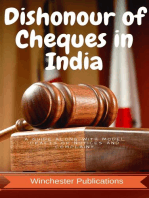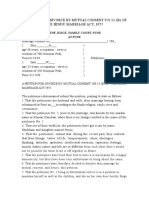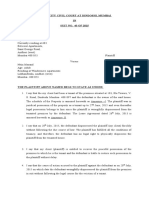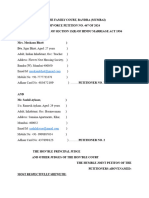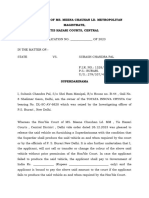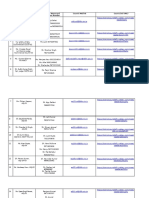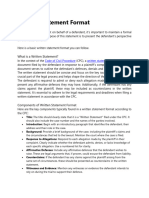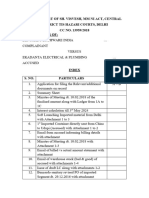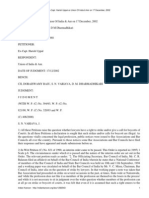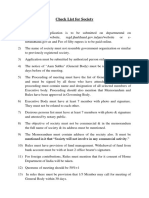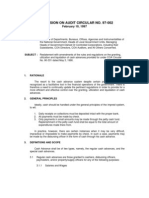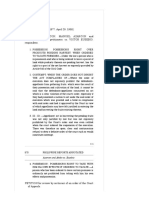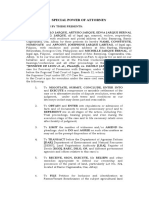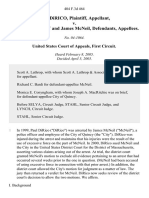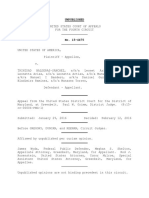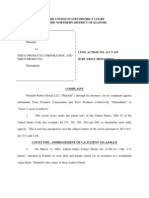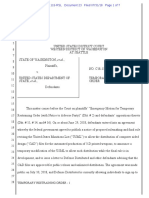Delhi High Court Judgment of One Bar One Vote
Delhi High Court Judgment of One Bar One Vote
Uploaded by
Latest Laws TeamCopyright:
Available Formats
Delhi High Court Judgment of One Bar One Vote
Delhi High Court Judgment of One Bar One Vote
Uploaded by
Latest Laws TeamOriginal Description:
Copyright
Available Formats
Share this document
Did you find this document useful?
Is this content inappropriate?
Copyright:
Available Formats
Delhi High Court Judgment of One Bar One Vote
Delhi High Court Judgment of One Bar One Vote
Uploaded by
Latest Laws TeamCopyright:
Available Formats
LatestLaws.
com
* IN THE HIGH COURT OF DELHI AT NEW DELHI
Reserved on: 21.08.2015
Pronounced on: 31.05.2016
W.P. (C) 8106/2010, CM APPL.2237/2013
PK DASH, ADVOCATE & ORS.
..... Petitioners
versus
BAR COUNCIL OF DELHI & ORS.
..... Respondents
W.P. (C) 6851/2012, CM APPL.17852, 17853/2012
NARESH KUMAR
..... Petitioner
versus
BAR COUNCIL OF DELHI AND ORS
..... Respondents
W.P.(C) 7549/2012
SATYANAND
..... Petitioner
versus
BAR COUNCIL OF DELHI AND ORS
..... Respondents
W.P.(C) 2689/2014
ANIL KUMAR SINGAL
..... Petitioner
versus
BAR COUNCIL OF INDIA AND ORS
..... Respondents
Appearance: Mr. Satyanand, petitioner in person in
W.P.(C)7549/2012.
WP(C) Nos.8106/2010, 6851/2012, 7549/2012 & 2689/2014
Page 1
LatestLaws.com
Mr. Anil Kumar Singal, petitioner in person in
W.P.(C)2689/2014.
Mr. Sacchin Puri with Mr. Apoorv Tripathi and Ms.
Hrishika Pandit, Advs for DHCBA.
Mr. Rajiv Khosla, Advocate/President, DHCBA.
Mr. Abhijat, Advocate/Hony. Secretary, DHCBA.
Mr. I.S. Saroha, Advocate/President, Rohini Court
Bar Association.
Mr. Vinod Sharma, Advocate/President, Saket
Court Bar Association.
Mr. Preet Pal Singh with Ms. Priyam Mehta, Advs.
for BCI.
Mr. Chetan Lokur, for Mr. Viraj R. Datar, Adv. for
DHC.
Mr. Divya Darshan Sharma, Adv/Hony. Secretary,
Delhi Bar Association.
CORAM:
HON'BLE MR. JUSTICE S. RAVINDRA BHAT
HON'BLE MR. JUSTICE SIDDHARTH MRIDUL
MR. JUSTICE S. RAVINDRA BHAT
%
[The advocate] has a duty to the court which is paramount. It
is a mistake to suppose that he is the mouthpiece of his client to
say what he wants: or his tool to do what he directs. He is none
of these things. He owes allegiance to a higher cause. It is the
cause of truth and justice. He must not consciously mis-state
[sic] the facts. He must not knowingly conceal the truth...He
must produce all the relevant authorities, even those that are
against him. He must see that his client discloses, if ordered, the
WP(C) Nos.8106/2010, 6851/2012, 7549/2012 & 2689/2014
Page 2
LatestLaws.com
relevant documents, even those that are fatal to his case. He
must disregard the most specific instructions of his client, if they
conflict with his duty to the court. The code which requires a
barrister to do all this is not a code of law. It is a code of
honour. If he breaks it, he is offending against the rules of the
profession and is subject to its discipline.
(Lord Denning)1
1.
It is the duty owed by the Bar to the Courts, which is in issue in
this common judgment which disposes of four writ petitions that call
for a decision of public importance involving the functioning of courts
and their orderly conduct. Briefly, all the petitions have a common
theme, i.e. that the principle of one Advocate one vote in one Bar,
should be introduced for all Bar Associations, irrespective of the
multitude of memberships of an advocate in Delhi; secondly the
petitioners seek directions for the introduction of the concept of one
person one chamber, one court complex only, in the city of Delhi.
2.
In WP (C)8106/2010 (described by the Petitioners name, i.e. as
Dash) the claim is that rules governing allotment of Chambers in
various court complexes should be amended to restrict eligibility to
one chamber in the entire territory of Delhi, for advocates, regardless
of the number of bar associations they are members of (i.e. hereafter
called one advocate, one chamber principle); the second claim is
that each advocate should be allowed only one voting right in regard
to a bar association of which he is member, regardless of the number
of such associations he chooses to belong to (hereafter referred to as
Rondel v Worsley 1966 (3) WLR 950
WP(C) Nos.8106/2010, 6851/2012, 7549/2012 & 2689/2014
Page 3
LatestLaws.com
the one advocate, one vote principle) and that directions should be
issued to mandate that within the city of Delhi, all Bar Associations
should hold elections not later than on expiration of two years term.
In WP 6851/2012 (hereafter Naresh Kumar) too the claim is for a
direction to introduce the one advocate one vote concept in the bar
associations so as to ensure that in any given year, an advocate can
vote only once in one bar association, regardless of her or his multiple
bar association memberships.
In WP(C)7549/2012 (hereafter
Satyanand) the claim is for directions to inter alia, ensure that only
genuine practitioners are members of the bar associations attached to
various courts in the city of Delhi, to safeguard that chambers are
allotted to genuine practicing advocates and that the transfer of
allotted chambers, is prohibited and discontinued. In WP 2689/2014
(hereafter Anil Sehgal) the claim is that the Bar Council of Delhi
should ensure the introduction of the principle of" One Bar, One Vote"
throughout all the Bar Associations in Delhi.
3.
It is argued by the Petitioners that Section 6 (1) (d) of the
Advocates Act,1961 (hereafter the Act) provides that the State Bar
Councils are to safeguard the rights, privileges and interest of
advocates on its rolls. Section 6 (1) (i), enables the State Bar Councils
to perform all other necessary functions for discharging functions
provided therein. The petitioners urge that there is an immense need to
frame definite rules, policies and guidelines involving the issues of
allotment of chambers, tenure of Bar Associations, and the procedure
for conducting free and fair elections of the Bar Associations on the
WP(C) Nos.8106/2010, 6851/2012, 7549/2012 & 2689/2014
Page 4
LatestLaws.com
principle of One Bar One Vote. The Petitioners submit that the issue
One Bar One Vote is squarely covered by the judgment of the
Supreme Court of India, in Supreme Court Bar Association v. B.D.
Kaushik2 which held that court-annexed Bar Associations are different
from other societies registered under the Societies Registration Act,
1860. It is submitted that even in Parliamentary and State Assembly
elections, a citizen of India is entitled to cast his vote at an election of
Legislative Assembly or an election of MP only in the constituency
where his name appears as a voter in the voting list and she cannot
claim a right to vote at another place where he or she may be residing
because of her or his occupation, service, etc. Thus One Bar, One
Vote is recognized statutorily for a long time. Therefore, in public
interest and the interests of ensuring smooth functioning of courts, it
should be mandated through directions.
4.
The Petitioners submit that the Supreme Court held that that the
One Bar One Vote principle or rule is a statutorily recognized
principle and it is the duty of the Bar Council to uphold that principle
in the spirit of the provisions prescribed under Section 6 (1) (d) of the
Act. It is stated that the said decision was re-affirmed in the Supreme
Court Bar Association & Ors. v. B.D. Kaushik3 (hereafter KaushikII). It is submitted that an advocate functions as a representative of
the legal profession and has a solemn duty to assist the Court in
ensuring that there is expeditious and smooth administration of justice.
In the larger interests of the judicial system and the orderly discharge
2
(2011) 13 SCC 774
(2012) 6 SCC 152
WP(C) Nos.8106/2010, 6851/2012, 7549/2012 & 2689/2014
Page 5
LatestLaws.com
of court functioning, submit counsel for the petitioners, the one
advocate one vote principle is essential. Highlighting that at present
there are more than a dozen Bar associations, including the Delhi High
Court Bar Association, the Supreme Court Bar Association, the CAT
Bar Association, and Bar associations for each Court Complex (Delhi
Bar Association for Tis Hazari Court complex, New Delhi Bar
Association for the Patiala Courts complex, Karkardooma Bar
Association, Rohini Bar Association, Dwarka Bar Association, Saket
Bar Association, Sales Tax Bar Association, etc) court functioning is
impeded and at times paralyzed due to elections held in one or other
court complex on different dates. It is submitted that under the
existing system, an advocate is free to contest for any position in the
executive committee or for any post as office bearer of any
association. This results in an individual who need not necessarily
practice in one court successfully getting elected for the association
attached to it. This practice, leads to unrepresentative election results
because such individuals have no sense of belonging and would not
hesitate to undermine the functioning of the courts whose Bar
Associations elect them. Besides, their role as representatives of a Bar
Association would be severely undermined if they also represent other
Bar Associations. In the event of conflicting positions of such Bar
Associations, the loyalty of such members elected in more than one
Bar Association would be suspect.
5.
It is next urged, on the issue of one chamber, one advocate, one
complex that at present, chambers are allotted without any
WP(C) Nos.8106/2010, 6851/2012, 7549/2012 & 2689/2014
Page 6
LatestLaws.com
accountability. As a result, there are a large number of lawyers who,
despite waiting for substantial period of time, have not been allotted
any chambers, whereas, many lawyers who have more than one
chamber, are also able to secure allotments and rent the chambers to
others. It is only Advocates who practice should be eligible for
allotment in the Advocates chamber blocks annexed thereto. With the
recent sharp increase in the number of advocates, there has been an
indiscriminate enrollment of advocates in multiple court annexed bar
associations.
In a majority of these cases, these lawyers do not
actually practice in Courts at all. Reliance is placed on a judgment of
this Court in the case of Nivedita Sharma v. Delhi High Court Bar
Association & Ors. [CS (OS) No. 2883 of 2011, order dated
23.11.2011].
6.
It is argued that the functioning of court annexed bar
associations has a direct impact on the functioning of the court and
also on the administration of justice. Court-annexed Bar Associations
constitute a separate class different from other lawyers associations
like the All India Advocates Association, Bar Association of India,
Law Asia, etc. and are always recognized by the concerned Courts.
Such Bar Associations function as part of the machinery for
administration of justice. Counsel urge that the Bench and the Bar are
two wheels of a chariot and one cannot function without the other.
The nature of the Bar Associations is such that it represents members
regularly practicing in the court and is responsible for proper conduct
of its members in the court, and for ensuring proper assistance to the
WP(C) Nos.8106/2010, 6851/2012, 7549/2012 & 2689/2014
Page 7
LatestLaws.com
court. In consideration, the court provides space for office of the
Association, library and other facilities like chambers at concessional
rates, parking place and canteen etc., besides other amenities for Bar
members regularly practicing in the court. It is therefore the duty of
this Court to ensure that the resources actually benefit the intended
beneficiaries.
7.
The Petitioners argue that the lack of any definite one advocate
one vote norm to regulate bar association elections will lead to a
situation where all office bearers of any given Bar Association may be
those not primarily practicing in the concerned Court, and comprise of
those regularly practicing elsewhere, perhaps in adjoining towns or
from far away cities like Chandigarh, Meerut etc. This would render
such Bar officials utterly unrepresentative; besides they would have
no appreciation or desire for ensuring reform and progress of their
constituents and the litigants whose primary needs are to be serviced.
8.
The result of the dominance of non-regularly practicing
advocates in the affairs of any given bar association renders it
impossible to pass any rules/resolutions with respect to the issues
raised by way of the present proceedings.
Article 226 of the
Constitution of India, submit the petitioners, empower High Courts in
cases, which involve a public element like the present case, to issue
directions even to private bodies, exercising a public function. It is
the nature of the functions and duties being performed by the said
body that is determinative of the jurisdiction under Article 226.
WP(C) Nos.8106/2010, 6851/2012, 7549/2012 & 2689/2014
Page 8
LatestLaws.com
9.
It is submitted that there can be no gainsaying that the
management and administration of a court annexed bar association
includes the discharge of a duty/function of a public nature. Proper
and smooth functioning of a bar association has a direct and intrinsic
bearing on the proper and effective functioning of the Court to which
it is annexed. Thus, court annexed bar associations perform functions
of a public nature and are thereby amenable to the jurisdiction of the
court under Article 226, in the present set of facts.
10.
It is submitted that in the Kaushik-I decision, the Supreme
Court, suo motu, prescribed guidelines to identify advocates regularly
practicing before the Supreme Court. In fact, this Court as well as all
other District courts in Delhi should follow the principle of allotting
chambers only to regularly practicing advocates as also the principle
of one advocate one chamber. It is submitted that in the Kaushik-II
judgment, the Supreme Court commended application of one bar one
vote principle. The Court held that one who exercises the right to
vote in more than a single Bar association, forms a different class than
a person who is a member of one Bar association, particularly, if such
bar association is annexed to the Court where she or he regularly
practices. Even the Bar Council of India has approved the rule of one
bar one vote. The said Resolution has been placed on record of this
Court. Counsel submit that the said rule has been also directed to be
applied for the State of Rajasthan, by the High Court of that state, in
WP(C) Nos.8106/2010, 6851/2012, 7549/2012 & 2689/2014
Page 9
LatestLaws.com
Poonam Bhandari v High Court of Rajasthan4
11.
It is argued by some petitioners that despite the rules of the
Rohini Bar Association providing for the principle of one bar one
vote, they are not followed. It is urged that during the course of
arguments all present, including the office bearers of the various Bar
Associations, agreed that curtailing the rights of a member is
acceptable to them in the case of allotment of chambers. It was
acceptable to all that only one chamber should be available to one
person and the right of such person to obtain a second chamber in
other bar association (s)/court complexes would stand automatically
curtailed. It is submitted that the rule of one bar one vote is on the
same footing as that of one advocate one chamber.
12.
It is crucial submit learned counsel - that the One Bar One
Vote rule can only be successful if it is implemented and applied to
all bar associations and not to a solitary association.
Counsel
emphasize that Bar Associations have a tendency to refuse to provide
a complete voters lists in order to frustrate transparency and
accountability. The same is evident from the various orders passed in
the present writ petitions, particularly, orders dated 01.11.12011 and
12.12.2012.
13.
There are two contradictory views espoused by members of the
Delhi High Court Bar Association. The one advocated by its Secretary
and members of the executive, excluding the President, support the
4
Judgment dated 26-11-2014 in DB (Civil) PIL (WP) No. 18688/2013
WP(C) Nos.8106/2010, 6851/2012, 7549/2012 & 2689/2014
Page 10
LatestLaws.com
Petitioners to highlight the influence of non-practicing/ irregularly
practicing advocates on the election process and mis-utilization of
chambers whereby the non-practicing advocates succeed in securing
chambers and rent them out to others. It is emphasized that the
indiscriminate admission of Advocates who do not have the High
Court as their principal Court of practice, the affairs of the Court
annexed bar associations increasingly vest with non-stake holders.
Such membership is acquired only to cast votes in favour of their
sponsors whenever they are candidates in the electoral fray.
14.
Reference is made to the orders dated 19.05.2011, 01.11.2011,
21.08.2012 and 12.12.2012, where issues involved in the present writ
petitions were identified and certain directions were issued to the
various parties. It is stated that the Delhi High Court Bar Association
is part of Delhi High Court. For that matter, any Bar Association
annexed to a Court will be a part of that Court. Such Bar Associations
have a duty to assist the Courts to which they are annexed, in
dispensation of justice. Members of the Bar constitute an integral part
of the justice delivery system.
Consequently, a Bar Association
whether registered or not, comes within the ambit of the concerned
Court and would always be subject to judicial scrutiny.
Court-
annexed Bar Associations constitute a separate class different from
other lawyers associations and are an integral part of the machinery
for administration of justice. The court-annexed Bar Associations start
their name with the concerned court; their nature implies that it is an
association representing members regularly practicing in the court and
WP(C) Nos.8106/2010, 6851/2012, 7549/2012 & 2689/2014
Page 11
LatestLaws.com
responsible for proper conduct of its members in the court and for
ensuring proper assistance to the court. In consideration, the court
provides space for office of the Association, library and other facilities
like chambers at concessional rates for members regularly practicing
in the court, parking place and canteen, etc., besides other amenities.
It is urged that under the Master Plan (MPD 2021) specific provisions
have been made that chambers are part of the Court and for the
purpose of Development Controls, (page 82 of the Master Plan in the
chapter Government Offices). The FAR granted to such
development includes lawyers chambers, canteen, library and other
ancillary services.
15.
It is argued that no Court can provide chambers and other
facilities to an advocate who is not regularly practicing in that court;
neither the Association nor the court can deal with such outsiders if
they commit any wrong. These factors were considered in Kaushik-I.
Even for the purpose for conferring the designation of Senior
Advocate, the number of judgments in cases in which the counsel was
present was considered to see whether the counsel was regularly
practicing before this Court. Thus the contribution to the cause of
justice by a regularly practicing advocate is established.
16.
The Delhi High Court Bar Association states that it bears
responsibility in assisting the Court in the dispensation of justice and
has a premier position amongst the High Courts of the country. This
has been possible because of the assistance rendered by members of
the Bar who regularly practiced and practice before it.
WP(C) Nos.8106/2010, 6851/2012, 7549/2012 & 2689/2014
Unless
Page 12
LatestLaws.com
restrictions are placed on the right to vote restricting it only for
members who regularly practice before the Delhi High Court, it will
virtually render the regularly practicing active members strangers in
their own court. This Court can only remedy this by exercising its
extraordinary jurisdiction under Article 226 of the Constitution of
India, vesting the right to vote only in members who regularly practice
before it. It is highlighted that membership of a Bar association
annexed to the court is a criteria adopted by this Court and by every
other court for allotment of chambers. The Supreme Court considered
this in Vinay Balachander Joshi v. Registrar General, Supreme Court
of India5 which is the rationale for regulating the Bar Associations
activities. It is submitted in this regard that the language of Article 226
does not make a distinction between public law and private law. The
jurisdiction of Article 226 can be exercised by this Court even against
a body of persons, which is not statutory, or is not incorporated, to
protect the rights and interests of an individual or the society or a class
of people. In the present case it affects the rights and privileges of
regularly practicing lawyers who are officers of this Court and thereby
creates an impediment in the justice delivery system. Reliance is
placed on the judgments of the Supreme Court that under Article 226
of the Constitution of India, in cases, which involve a public element
like the present case, writ/orders can be issued/passed against a private
body, exercising a public function. It is the nature of the functions
and duties being performed by the said body that is determinative of
[(1998) 7 SCC 461
WP(C) Nos.8106/2010, 6851/2012, 7549/2012 & 2689/2014
Page 13
LatestLaws.com
the jurisdiction under Article 2266. It has been held by the Supreme
Court in Binny Ltd. & Anr. V. V. Sadasivan & Anr.7 , that a public
function may be one where the body seeks to achieve a collective
benefit for the public or for a section of the public and is accepted by
the public or the section of the public as having authority to do so.
17.
It is argued that an advocate functions as a representative of the
legal profession. It is an advocates solemn duty to assist the Court in
ensuring that there is expeditious and smooth administration of justice.
The Petitioners submit that the duty performed by an advocate is of a
public nature8.
There is no gainsaying that the management and
administration of a court annexed bar association includes the
discharge of a duty/ function of a public nature. It is also submitted,
AndiMuktaSmarak Trust & Anr. v. V.R. Rudani & Anr. ((1989) 2 SCC 691 (Para
17, 20 and 22); Zee Telefilms & Anr. v. Union of India & Ors. (Constitution
bench) (2005) 4 SCC 645 (Para 31-33), BCCI v. Cricket Association of Bihar &
Ors.,(2015) 3 SCC 251
(2005) 6 SCC 657. (Para 10-12, 29, 32)
Reliance is placed on Vinod Kumar Bharadwaj v. State of MP & Ors., (AIR 2013
MP 145) and Punjab and Haryana High Court Bar Association & Anr. v. Union
of India & Ors, 2007 SCC OnLine P&H 632 (Para 10); and Advocates
Association, Bangalore v. The Chief Minister, Govt. of Karnataka, (AIR 1997
Kant 18) (Para 22, 27-28, 31)
WP(C) Nos.8106/2010, 6851/2012, 7549/2012 & 2689/2014
Page 14
LatestLaws.com
by relying on three decisions of the Allahabad High Court9 that a court
annexed bar association (in those cases the Uttar Pradesh High Court
Bar Association) may be amenable to writ jurisdiction under Article
226 of the Constitution of India, in light of the fact that the proper and
smooth functioning of the bar association has a direct and intrinsic
bearing on the proper and effective functioning of the Court to which
it is annexed and also in light of the difficulties being faced by the
Uttar Pradesh High Court Bar Association.
18.
Reliance is placed on an order dated 11.12.201310, the Supreme
Court directed that the principle of one bar one vote will be
applicable to the elections of the Delhi High Court Bar Association
(for the year 2013). It was also directed that a committee be formed
for scrutinizing the list of voters and that further, the committee should
seek declaration from each member as to whether the member had
voted in any other elections and further mandated that all bar
associations would provide details in a time bound manner with
respect to the members which had voted in their elections. There was
no issue involved in the said appeal (s) with respect to implementation
of the concept of the one vote one bar, nor was the said rule included
9
Ajay Pratap Singh v. Oudh Bar Association & Ors., MANU/UP/0330/2014 (para
10-12); and Sunita Sharma v. Dy. Registrar, Chits and Funds Society, AIR 2014
All 141. (para 20, 22-25, 28)
10
Rajiv Khosla v. Delhi High Court Bar Association & Ors (C.A No.10987-90 of
2013) with Delhi Bar Association & Ors. v. Delhi High Court Bar Association &
Ors.; Delhi High Court Bar Association & Ors. V. Rajiv Khosla; and Delhi High
Court Bar Association & Ors. v. Delhi Bar Association & Ors.
WP(C) Nos.8106/2010, 6851/2012, 7549/2012 & 2689/2014
Page 15
LatestLaws.com
in either the original or the amended constitution/rules of the Delhi
High Court Bar Association. The said rule was imposed suo motu by
the
Supreme Court for the benefit of the Delhi High Court Bar
Association. It is highlighted that the Delhi High Court Bar
Association, by resolution dated 28.03.2001, under the category of
Any Other Item No.5, observed that as various advocates, who are not
registered with the Delhi Bar Council are filing Vakalatnama, causing
serious prejudice to administration of justice, therefore, outside
advocates must seek assistance of a local advocate, who is enrolled
with Delhi Bar Council and is preferably member of the Delhi High
Court Bar Association. The Bar Council of Indias decision (through
its General Council), by resolution No.169 of 2015, approving the rule
of one bar one vote, stating it to be good for the institutions and
associations is pressed into service.
19.
It is stated that two Bar Associations in Delhi already provide
for the rule of one bar one vote but do not follow the same. The
Constitution of the Rohini Court Bar Association and Saket Court Bar
Association provides for One Bar One Vote but the implementation of
the same has not been possible till date.
During the course of
arguments, all present, including the office bearers of the various Bar
Associations were ad-idem that curtailing the rights of a Member of a
Bar Association is acceptable to them vis--vis allotment of chambers.
It was acceptable to all that only one chamber should be available to
one person and the right of such person to obtain a second chamber in
other bar associations(s)/ court complexes would stand automatically
WP(C) Nos.8106/2010, 6851/2012, 7549/2012 & 2689/2014
Page 16
LatestLaws.com
curtailed. It is submitted that the rule of one bar one vote is on the
same footing as that of one advocate one chamber. A bare perusal of
Annexure 1 makes it evident that all bar associations follow the rule of
one person one chamber. A departure cannot be made for voting
rights. It is submitted that in the Delhi High Court Bar Association
presently 13,829 advocates are enrolled as members, of which not
more than 2000 advocates regularly appear and practice before this
Court. Other court annexed bar associations in Delhi face the same
problem. As a result, such members exercise a greater control and
have a greater say in the affairs and management of the said court
annexed bar associations than regularly practicing advocates, thereby
making it impossible for such bar associations to pass any rule/
resolution so as to reduce the participation of such advocates. In fact,
the need of the hour is to not only implement and enforce the one bar
one vote principle, following the law laid down by the Supreme Court
as also approved the Bar Council of India by a recent Resolution, but
to evolve guidelines for determining regularly practicing advocates.
The rule of One Bar One Vote can only be successful if it is
implemented with respect to all bar associations and not only the
Delhi High Court Bar Associations.
20.
It is argued that citizens have a Fundamental Right to form and
continue an Association; a citizen has no right to insist on becoming
member of an association. Other common conditions, with which the
association was formed, must be fulfilled, before a person can be
considered for membership of an association. The continued
WP(C) Nos.8106/2010, 6851/2012, 7549/2012 & 2689/2014
Page 17
LatestLaws.com
allegiance to the common purpose, interest and welfare is also
mandatory to continue the membership of an association. A person
who has no common interest or common purpose with which the
Association was formed has no right to insist on becoming a member
of such an association; or continue to be a member of such an
association. Reliance is placed on the Supreme Court decision in A.P.
Dairy Development Corporation Vs B. Narasimha Reddy11 which
explained the right as follows:
26. Therefore, the freedom Guaranteed under Article 19(1)(c)
is not restricted merely to the formation of the association, but
to the effective functioning of the association so as enable it to
achieve the lawful objectives.
Consequently, the effective functioning of DHCBA and other court
annexed Bar Associations pre-suppose that the Courts mandate
effective mechanisms ensuring democratic representation of their
members.
21.
It is submitted that other Bar Associations have a tendency to
refuse to provide voters lists in order to frustrate the rule as was done
during the 2014 elections of the Delhi High Court Bar Association,
wherein, notwithstanding orders of the Supreme Court, there was
refusal to cooperate and provide names of persons who had voted in
their respective elections. In fact, it is verily believed that a large
number of voters cast their votes irrespective of the fact that they had
voted in the year 2013 in different bar elections and only a small
11
(2012) 9 SCC 289
WP(C) Nos.8106/2010, 6851/2012, 7549/2012 & 2689/2014
Page 18
LatestLaws.com
number of voters furnished genuine declarations. The same is also true
as regards the various orders passed in the present writ petitions,
particularly, orders dated 01.11.2011 and 12.12.2012. In light of the
aforementioned submissions, it is submitted that this Court, in exercise
of the extraordinary powers conferred upon it under Article 226 of the
Constitution of India, should issue detailed guidelines/ evolve criteria
for identifying advocates who can be said to be regularly practicing
in a court for the purpose of having the right to vote in the elections of
the Bar Association annexed to such Court. While considering such
guidelines, due regard may be given to the appearances of an advocate
in the said Court. The said guidelines should be accompanied by the
implementation and enforcement of the principle of one bar one vote
in this Court as also in all District Courts in the State of Delhi.
The opposing view: the Position of the District Courts Bar
Associations and of the President, DHCBA
22.
In opposition to the arguments of the petitioners and that of the
Secretary and members of the executive committee of the DHCBA,
the Bar Associations of District Courts complexes and the President of
DHCBA, Mr. Rajiv Khosla urge that the one advocate one vote
principle cannot be imposed by this Court, in exercise of its
jurisdiction under Article 226 of the Constitution of India. It is
submitted that the Bar Associations are not statutory bodies, but
merely represent the interests of their members, i.e., lawyers. They do
not possess any regulatory control or power over the functioning of
enrolled lawyers, nor can discipline them for misconduct. Their
WP(C) Nos.8106/2010, 6851/2012, 7549/2012 & 2689/2014
Page 19
LatestLaws.com
function is to merely highlight and espouse causes concerning
Advocates and channelize their grievances with the Courts and act as
facilitators to ensure that common goals of the lawyer community as
one of professionals is achieved. If any body is to decide upon the
applicability or otherwise of the principle of one man one vote, argue
these Bar Associations, it is the General Body of members of each
association which can achieve that end, through accepted means, such
as moving a resolution amending their constitution and Bye-laws.
23.
It is submitted that neither the Bar Council of any State nor the
Bar Council of India have any powers to interfere in the affairs of the
Bar Associations and cannot command them to amend its constitution
without having a General Body meeting which is in contravention of
Kaushik-II. It is submitted that the issues have already been taken up
before several benches of this Court and some related matters have
even reached the Supreme Court whereby it was found mandatory to
seek approval of General House for bringing any amendment in the
manner prescribed under Rule 33 of the constitution of DHCBA.
24.
It is argued by the respondent Bar Associations that the
Supreme Court while disposing of SLP No.37266/2013 had never
stated that the rule of One Vote One Bar had to be adopted for future
elections of DHCBA. The only condition which the Supreme Court
imposed was in respect of the particular elections held during that
period and it was a solution suggested by the Supreme Court which
stated that the issue in dispute shall be decided on merits by the
concerned court. Highlighting that interference by any Bar Council in
WP(C) Nos.8106/2010, 6851/2012, 7549/2012 & 2689/2014
Page 20
LatestLaws.com
the affairs of DHCBA cannot be countenanced; reliance is placed on
the judgment of a Single Judge in WP(C) 6756/2013. In this regard it
is further submitted that the Bar Council being a statutory Body is
governed by the rules and regulations and there is nothing in the rules
to suggest that the Bar Council can pass any direction with regard to
curtailing the voting rights of the members of any Bar Association in
violation of the constitution of such Bar Association.
25.
It is submitted that number of judgments have held that anyone
who is not a party to any legal proceedings cannot be allowed to
participate in the proceedings without permission of the court unless
impleaded as a party. Since no such permission whatsoever was
granted by this Court to BCI or even sought by it, the Bar Council nor
anyone else can place any document on record. Even otherwise the
BCI is not empowered to pass such resolution and the Bar
Associations are under no obligation to accept the same.
26.
Mr. Khosla highlighted that that the One Bar One Vote
principle considered by Kaushik-II was made only by the General
House in consonance with the constitution of Supreme Court Bar
Association and it was only thereafter, the Supreme Court with the
suggestion of Bar Association made certain directions resulting in the
mechanism for implementation of the said amendments. It is urged
that even otherwise the present petition pertaining to One Bar One
Vote has nothing to do with the elections of Delhi High Court Bar
Association, as DHBCA cannot be equated with any District Court
Bar Association. The Delhi High Court is a peculiar High Court,
WP(C) Nos.8106/2010, 6851/2012, 7549/2012 & 2689/2014
Page 21
LatestLaws.com
which has Original Jurisdiction, and all lawyers practicing in Delhi
have to approach the High Court for filing their matters. Moreover the
High Court being situated at a central place, is within easy access to
all the Advocates working in different courts. The availability of
chambers in High Court is very small and the waiting period to get a
chamber in High Court is 25 years and more, compelling the lawyers
to take chambers at other District Courts. Therefore, the concept of
ONE VOTE ONE BAR cannot be made applicable to DHCBA.
27.
The respondent Associations argue that this Court should desist
from issuing the directions sought in these writ petitions, as the
important issue is in respect of interference of the court in the
autonomous
functioning
of
Bar
Associations
affecting
their
independence. It is submitted that interference by imposing any rule or
principle on the assumption that it would achieve greater democracy
or give voice to a section of the Bar who are regular practitioners,
would set a wrong precedent. Here, it is argued that the right to
practice before the High Court is assured by law to all members who
enroll with the Bar Council. The Delhi Bar Council is a State level
statutory entity. If all its members are equal as practitioners before this
Court, it cannot discriminate in favour of those who regularly
practice before it, and those who do not do so. The direction sought by
the petitioner is nothing but one favoring those who regularly
practice before particular courts. Stripping voting rights from nonregularly practicing lawyers would be both discriminatory and an
interference without a legal framework. It is submitted that the use of
WP(C) Nos.8106/2010, 6851/2012, 7549/2012 & 2689/2014
Page 22
LatestLaws.com
parking sites, canteen and other public facilities are intrinsic to the
Court as a public service provider; they cannot be denied to Advocates
who appear before it. There is no such law that mandates the one man
one vote rule; consequently a court-imposed rule would be untenable.
28.
As regards the other issue i.e. strict implementation of the
policy of providing one chamber one advocate to the lawyers
practicing in various District Courts in Delhi to ensure that the other
lawyers in the waiting list may not be deprived of their right to get
chambers in the court complex, it is stated that the chamber allotments
in various District courts have been made in terms of policies framed
by this Court on the Administrative side. These policies are enforced
by the respective Chamber Allotment Committees of all District
Courts in Delhi and consequently, the allotment of chambers in
various courts situated in different parts of Delhi so much so, the said
principle was followed by this Court while deciding various writ
petitions being filed by aggrieved advocates in respect of allotment of
chamber. The said issue has also been dealt by this Court by orders
dated 01.04.2011, 01.11.2011 and 12.12.2011 whereby directions
were given to District Judges to place on their respective websites, the
complete information with regard to chamber allotments with timely
updating. Therefore, the said issue does not require any further
adjudication.
Analysis and conclusions:
29.
The respondent Bar Associations opposition to a Court
WP(C) Nos.8106/2010, 6851/2012, 7549/2012 & 2689/2014
Page 23
LatestLaws.com
mandated one advocate one vote regime principally is rooted on the
argument that it is not for courts, but members of each association to
decide whether to adopt such a rule or not. The right to form an
association, so goes the submission, fundamentally clothes the
members and none else, with the right to decide upon matters touching
its affairs. The petitioners, quite naturally, oppose this, by focusing on
the Courts role as regulator of issues central to administration of
justice; they also highlight that left untouched, the objective of
permitting court-annexed Bar Associations to be bodies representing
practitioners of a given court is defeated as rank outsiders having no
practice or stake will occupy all positions of decision making, and bar
genuine practitioners in those courts. Similar arguments are made with
respect to the one-man one chamber issue though the division of
opinion is less sharp.
30.
The two opposing arguments i.e. votaries or proponents of the
one man one vote rule, and those who resist it, thus focuses on the
right to association (perhaps stemming from the right to form
associations, under Article 19(1)(c) of the Constitution (hereafter
called the association right) the attending autonomy to conduct
affairs of such institutions on the one hand, and the Courts
compelling interest in regulating it, on the other hand. It is worthwhile
noticing that in Kaushik-I as well as Kaushik-II the powers of the
Court to deal with this question was not in issue. Furthermore, the
Supreme Court exercised its powers under Article 142 of the
Constitution of India.
WP(C) Nos.8106/2010, 6851/2012, 7549/2012 & 2689/2014
Page 24
LatestLaws.com
31.
As various submissions with regard to the issues noticed earlier
were advanced, it would be useful to decide upon the following:
(a) Power and jurisdiction of the Court under Article 226 of the
Constitution of India;
(b) The extent of the association right and the Courts jurisdiction
to mandate a regime of one man one vote.
Point No. (a)
32.
As far as the first question, i.e maintainability of these
proceedings under Article 226 of the Constitution are concerned, the
law is now settled that what is determinative is not merely the nature
of the organization, but the function it performs, that is the subject
matter of controversy. This was summarized by the Constitution
Bench of the Supreme Court in Zee Telefilms v Union of India12. The
Court held- even while rejecting the contention that the Board of
Control for Cricket in India (BCCI) was not "State" within the
meaning of the expression under Article 12, that:
"Thus, it is clear that when a private body exercises its public
functions even if it is not a State, the aggrieved person has a
remedy not only under the ordinary law but also under the
Constitution, by way of a writ petition under Article 226.
In the judgment reported as Federal Bank v Sagar Thomas13it was
held that:
12
2005 (4) SCC 649
2003 (10) SCC 733
13
WP(C) Nos.8106/2010, 6851/2012, 7549/2012 & 2689/2014
Page 25
LatestLaws.com
"From the decisions referred to above, the position that
emerges is that a writ petition under Article 226 of the
Constitution of India may be maintainable against (i) the State
(Govt); (ii) Authority; (iii) a statutory body; (iv) an
instrumentality or agency of the State; ( v) a company which is
financed and owned by the State; (vi) a private body run
substantially on State funding; (vii) a private body discharging
public duty or positive obligation of public nature (viii) a
person or a body under liability to discharge any function under
any Statute, to compel it to perform such a statutory function."
Likewise, in Binny V. Sadasivan14 the Supreme Court held as follows:
"Thus, it can be seen that a writ of mandamus or the remedy
under Article 226 is pre-eminently a public law remedy and is
not generally available as a remedy against private wrongs. It
is used for enforcement of various rights of the public or to
compel the public/statutory authorities to discharge their duties
and to act within their bounds. It may be used to do justice
when there is wrongful exercise of power or a refusal to
perform duties. This writ is admirably equipped to serve as a
judicial control over administrative actions. This writ could
also be issued against any private body or person, specially in
view of the words used in Article 226 of the Constitution.
However, the scope of mandamus is limited to enforcement of
public duty. The scope of mandamus is determined by the nature
of the duty to be enforced, rather than the identity of the
authority against whom it is sought. If the private body is
discharging a public function and the denial of any right is in
connection with the public duty imposed on such body, the
public law remedy can be enforced."
The question, which this Court has to address, is whether, in the light
of the above principles enunciated by the Supreme Court, can the
present proceedings be maintained validly against the respondent Bar
14
2005 (6) SCC 657
WP(C) Nos.8106/2010, 6851/2012, 7549/2012 & 2689/2014
Page 26
LatestLaws.com
Associations. They assert that such proceedings cannot be maintained,
because they are purely private bodies, voluntarily formed with their
own Constitutions. They also assert that in exercise of the power under
Article 226, this Court cannot mandate them to include stipulations for
introducing the one Bar one vote principle.
33.
At the heart of the issue lies the question: do any of the issues in
controversy involve a public element. As this Court perceives it, there
can be no two opinions on this: the answer has to be an unequivocal
affirmative. An Advocate (who is the unit for whom all respondents
avowedly stand, as representative bodies) engaged in law practice,
before Courts in India, occupies a crucial and important position. She
or he has the exclusive privilege, by law, to appear and represent
others in cases and causes tried and decided by courts. This privilege
is conditioned by provisions of the Advocates Act; it is also subject to
continued good conduct- any lapse or actionable misconduct is liable
to disciplinary action, the manner of whose proceedings and the nature
of penalties that can be imposed, are again expressly stipulated by
law- either under the Advocates Act, or under Regulations framed
thereunder. Statutory appeals are provided against penalties imposed
and the right to ultimately appeal to the Supreme Court is also assured.
Every Advocate is duty bound to follow the code of conduct15
formulated by the Bar Council of India. These standards - especially
15
Standards of Professional Conduct and Etiquette - framed under Rules and
Section 49 (1) (c) of the Act read with the Proviso thereto of the Advocates Act.
WP(C) Nos.8106/2010, 6851/2012, 7549/2012 & 2689/2014
Page 27
LatestLaws.com
the Preamble, vividly summarize what is required and expected of an
Advocate at all times:
"An advocate shall, at all times, comport himself in a manner
befitting his status as an officer of the Court, a privileged
member of the community, and a gentleman, bearing in mind
that what may be lawful and moral for a person who is not a
member of the Bar, or for a member of the Bar in his nonprofessional capacity may still be improper for an advocate.
Without prejudice to the generality of the foregoing obligation,
an advocate shall fearlessly uphold the interests of his client
and in his conduct conform to the rules hereinafter mentioned
both in letter and in spirit. The rules hereinafter mentioned
contain canons of conduct and etiquette adopted as general
guides; yet the specific mention thereof shall not be construed
as a denial of the existence of others equally imperative though
not specifically mentioned."
34.
The professional activities of every Advocate - qualifications
recognized, requirement of being enrolled, conditions for continuous
enrolment, obligation to follow a prescribed code of conduct, comport
herself with dignity and also assist the Court, duty to represent clients,
accountability for action and lapses duties of statutory authorities,
such as the Bar Council of India and State Bar Councils, maintenance
of rolls, disciplinary proceedings and the manner of their conduct, are
regulated by law. All this is to one end: provide a service to the client,
in an orderly and regulated manner, professional assistance of an
individual trained in the discipline of the law to secure the timely and
efficient of resolution of a dispute before the Court.
WP(C) Nos.8106/2010, 6851/2012, 7549/2012 & 2689/2014
Page 28
LatestLaws.com
35.
The status of an Advocate as an "officer of the court",- owing a
duty beyond her brief, to uphold the law and at all times act in fairness
towards the Court, her colleagues and her client, without using sharp
tactics or illegitimate means has been emphasized repeatedly in
several decisions. The Supreme Court in Lalit Mohan Das v Advocate
General explained this16:
"..a member of the Bar is an officer of the Court and owes a
duty to the Court in which he is appearing. He must uphold the
dignity and decorum of the Court and must not do anything to
bring the Court itself into disrepute"
The Supreme Court described the Advocate's status as "the exalted
position conferredunder the judicial system prevalent in the
country" (R.D. Saxena v Balram Sharma17).
36.
Given this position of Advocates in Courts in India, and the
importance of their role in judicial decision making, their conduct in
respect of matters not regulated by law may appear, on the faade,
beyond the pale of what may be described as "public functions". Yet,
that is not the case. Bar Associations- like the respondents, apart from
the statutory bodies such as Bar Councils, also occupy a pivotal role in
Court administration and functioning. This can be gathered from the
fact that Court procedure is framed after consultation with such Bar
Associations, important policy and administrative decisions such as
rules to allot chambers, use of common spaces, allotment of
commercial spaces, their identification (all meant for the use of the
16
17
AIR 1957 SC 250
2000 (7) SCC 264
WP(C) Nos.8106/2010, 6851/2012, 7549/2012 & 2689/2014
Page 29
LatestLaws.com
litigant public and members of the Bar) earmarking of parking lots,
policies and rules for designation of senior counsel under the
Advocates Act, are taken, more often than not, with the consultation
and inputs from these Bar Associations, in view of their representative
nature. Any dispute within such association invariably has
repercussions in court functioning. Conflicts with members of the
public, interface with the local administration and police authorities
routinely - for security of court, court precincts, chambers, etc. need
active participation by Bar Associations. Often, individual grievances
of members of the Bar in court premises require intervention and deft
handling on the part these Associations, in the absence of which Court
proceedings would be disrupted. Above all, elections of Bar
Associations quite often lead to large-scale requests for adjournments,
and litigants have to pay the price. Intervention through court policies
requiring discipline in canvassing for votes and what is permissible in
the form of leaflets and pamphlets, use of speakers, etc, by the Bar
Associations, if left unregulated would also seriously undermine court
functioning. These show that Bar Associations' activities have a predominantly public character, and can, in many instances, affect court
functioning. As a result, it is held that the nature of relief sought in
these proceedings is intrinsically connected with public functioning of
the court and affect them. Consequently the present proceedings are
maintainable under Article 226 of the Constitution of India.
Point (b)
37.
As noticed previously, though it is not articulated with
WP(C) Nos.8106/2010, 6851/2012, 7549/2012 & 2689/2014
Page 30
LatestLaws.com
precision, the respondent associations that oppose introduction of the
one man one vote rule do so on the basis of the association right.
The assertion here is that it is only for members of each association to
decide whether or not to introduce such a rule; the second argument is
that the distinction between regular practitioners and non-regular
practitioners is artificial, given that both categories have same voting
rights and right to appear before each court; lastly it is urged that the
Supreme Courts formulation in the Kaushik series of judgments was
contextual because the SCBA had resolved to introduce such a rule
and the Court exercised its powers under Article 142.
38.
The association right is one of the freedoms guaranteed by the
Constitution of India [Article 19(1)(c)]. It has been described as the
right of every citizen to ..(c) to form associations or unions. Yet,
this right is not absolute, or incapable of regulation it is subject to
reasonable restrictions which the State (a compendious term,
incorporating the Central and State legislatures, Executive authorities
and agencies under their control, by reason of Article 12) can impose,
in the interests of.. The Supreme Court has held [Damyanti
Naranga v. Union of India& Ors.]18 that this right clothes an
association and its members the right to refuse membership to those
not acceptable to the existing body of members. Within its sphere of
activity, an association has the right of internal management.
Nevertheless, the association right does not render the institution
immune from takeover of management by the State or executive
18
AIR 1971 SC 961
WP(C) Nos.8106/2010, 6851/2012, 7549/2012 & 2689/2014
Page 31
LatestLaws.com
agencies, if its functioning is deleterious to the interests of its
members or the general public (The Board of Trustees, Ayurvedic And
Unani Tibia College, Delhi v. The State of Delhi and Another, AIR
1962 SC 458; S.P. Mittal v. UOI and Ors. AIR 1983 SC 1and Daman
Singh and Ors. v. State of Punjab and Ors AIR 1985 SC 973). The
existence then of the association right ipso facto is no guarantee that if
the functioning of the institution is not conducive to its objects, it
would nevertheless be left alone. This right does not carry with it the
right to recognition (Raghubar Dayal Jai Prakash v. Union of
India19). The expression form means not only establishing an
association at the stage of its formation, but also to continue with the
association: this was held in V.G. Row v The State of Madras20,in the
following words:"The word "form" therefore, must refer not only to the initial
commencement of the association, but also to the continuance of
the association as such."
39.
The Supreme Court in State of Madras v V.G. Row21 did not
depart from this view. In a significant later judgment, i.e. All India
Bank Association Vs. National Industries Tribunal22 it was held that
even a very liberal interpretation of the said constitutional provision
cannot lead to the conclusion that the fundamental right to form
unions carries with it a concomitant guarantee that the trade unions so
formed shall be enabled to carry, effective collective bargaining or
19
AIR 1950 SC 263
AIR 1951 Madras 147
21
AIR 1952 SC 196
22
AIR 1962 SC 17
20
WP(C) Nos.8106/2010, 6851/2012, 7549/2012 & 2689/2014
Page 32
LatestLaws.com
shall achieve the purpose for which they were brought into existence.
The court held:
In our opinion, the right guaranteed under sub-clause (c)
of clause (1) of Article 19 extends to the formation of an
association and insofar as the activities of the association
are concerned or as regards the steps which the union might
take to achieve the purpose of its creation, they are subject
to such laws as might be framed and the validity of such
laws is to be tested by reference to the criteria to be found in
clause (4) of Article 19 of the Constitution.
T.K. Rangarajan Vs State of Tamil Nadu23was a decision where the
Supreme Court held that the right to form an association does not
carry with it the right to strike work. The earlier decision of the
Supreme Court- in Damayanti Naranga v Union of India24[1971] 3
SCR 840 was in the context of a take-over of a registered society by
the State after which a new body was constituted, with the old
membership intact, but a few others added. The Court held this to be
beyond States power:
The result of this change in composition is that the members,
who voluntarily formed the Association, are now compelled to
act in that Association with other members who have imposed
as members by the Act and in whose admission to membership
they had no say. Such alteration in the composition of the
Association itself clearly interferes with the right to continue to
function as members of the Association which was voluntarily
formed by the original founders. The right to form an
association, in our opinion, necessarily implies that the persons
forming the Association have also the right to continue to be
23
24
AIR 2003 SC 3032
[1971] 3 SCR 840
WP(C) Nos.8106/2010, 6851/2012, 7549/2012 & 2689/2014
Page 33
LatestLaws.com
associated with only those whom they voluntarily admit in the
Association. Any law, by which members are introduced in the
voluntary Association without any opinion being given to the
members to keep them out, or any law which takes away the
membership of those who have voluntarily joined it, will be a
law violating the right to form an association".
40.
In Daman Singh v. State of Punjab25 1985 (2) SCC 670 (SCC at
p.681), the Constitution Bench had held that the creation, the
constitution and the management of the society is a creature of the
statute. They are controlled by the statute and therefore, there can be
no objection to statutory interference with their composition on the
ground of contravention of the individual right to freedom to form
association. The validity of Section 13 (8) of the particular statute,
which enabled the amalgamation of various co-operative societies,
was upheld. The Court held that once a person becomes a member of a
Cooperative Society, she loses her individuality vis--vis the society
and she has no independent rights except those given by the statute
and the byelaws. She must act and speak through the society or rather;
the society alone can act and speak for her vis--vis rights or duties of
the society as a body.
41. Rule 18 of the Supreme Court Bar Association enlists the
modalities of the electoral process to the SCBA. Clause III
particularly, restricts the right of participation in the process
(participation encompassing both the right to vote as well as the right
to contest for a position) to only those members who have not
exercised their right to vote in any High Court or District Courts Bar
25
1985 (2) SCC 670
WP(C) Nos.8106/2010, 6851/2012, 7549/2012 & 2689/2014
Page 34
LatestLaws.com
Association election. In other words, a member of the SCBA, along
with other conditions, must have desisted from participating in the
electoral process of any other Bar Association attached to any other
court. The Rule essentially mandates that a member of the SCBA must
elect either between being part of the electoral process of the SCBA or
any other Court; she or he is not permitted to exercise both rights
simultaneously. The Rule reads as under:
III A member who exercises his right to vote in any year in
any High Court or District Court Advocates/Bar Association
election shall not be eligible to contest for any post of the
Association or to cast his vote at the election. Every member
before casting his vote shall in the prescribed form give a
Declaration that he is not voting in any other election of any
High Court/District Court Bar Association. Provided, however,
that if such a declaration is found to be false, it shall entail
automatic suspension of the member giving such false
declaration from membership of this Association for a period of
three years.
The SCBA shall prepare a list of Voters based on the
declaration made by the members. Only such members whose
names are included in the final voters list shall be entitled to
vote, contest, propose and second any candidate in SCBA
Election.
The framing of a norm of non-participation in any other Bar
Association election as a condition precedent for the eligibility to vote
or contest for a post in the SCBA, the rule was upheld in the face of a
challenge made before the Supreme Court in Kaushik-I. The Court,
while refusing to interfere with the Rule stated that:
23. It is important to notice that what the impugned Rule does
WP(C) Nos.8106/2010, 6851/2012, 7549/2012 & 2689/2014
Page 35
LatestLaws.com
is that it only declares the eligibility of a member to contest and
vote and does not take away ipso facto the right to vote. The
impugned Rule only prescribes the eligibility or makes a person
ineligible in the circumstances stated therein which is the
nature of a reasonable restriction as the right to vote is neither
a common law right nor Fundamental Right but a statutory
right prescribed by the statute as has been held in several
reported decisions of this Court. What is necessary to be
noticed here is that the impugned clause in the Rule is not the
only clause prescribing ineligibility to vote as there are other
eligibility conditions or ineligibility restrictions within Rule 18,
which may also make a person ineligible to vote. The challenge,
therefore, to this ineligibility of filing a declaration not to vote
at the elections to any other Bar Association is erroneous in
law. If a person is the member of several associations of
advocates and wants to participate in the affairs of different
associations of which he/she is a member, he/she may not be in
a position to be really involved in the affairs of all associations
of which he/she is the member. A person who is a member of
more than one association would form a different class than the
person who is a member of only one association of lawyers,
particularly, the association of the Court in which he/she
regularly practices. Though an advocate can be member of
several associations, the right to form an association or be a
member of an association does not necessarily include the right
to vote at every such association's General Body Meeting or
election meetings and the rules of the association can
circumscribe the voting rights of members of such association
by prescribing eligibility and ineligibility. It is an admitted
position that SCBA today has temporary members who do not
have a right to vote. Similarly, non-active members and
associate members do not have a right to vote.
WP(C) Nos.8106/2010, 6851/2012, 7549/2012 & 2689/2014
Page 36
LatestLaws.com
Thus, these are all reasonable restrictions which have been
prescribed and are not open to challenge as there is no
Fundamental Right to vote. After all a Bar Association in a
court is formed for the purpose of seeing that all lawyers
practicing normally and regularly in that court work under one
umbrella and be in a position to interact with the Judges or
officials of that court for any grievance through their elected
body because individual lawyers are not supposed nor it is
proper for them to interact with the Judges so as to preserve
and secure the independence of judiciary.
42. Clearly therefore, there is sound rationale to regulate - rather to
impose restrictions that impinge on the Advocates association right or
for that matter, the right to vote. That being said, the right to vote in a
society is neither a fundamental nor a constitutional right. Its
regulation cannot therefore in any event be tested in the same manner
reserved for fundamental rights, which enjoy an exalted position
within the conspectus of rights, citizens of this country are entitled to.
There is yet another point which counters the respondents argument.
The rule itself, much like the SCBA rule does not cease to or render
meaningless any volition on part of the Advocate. It merely mandates
that a choice out to be made about the right to vote, if one member is
also member of another association. The other membership rights are
left untouched. All that the rule or one man one vote principle
imposes, if one may say so, is a duty upon the Advocate to choose, to
decide for herself or himself, which association she would rather be a
voting member of. It confers the responsibility of evaluating where her
or his allegiance lies or which association he or she must invest in.
WP(C) Nos.8106/2010, 6851/2012, 7549/2012 & 2689/2014
Page 37
LatestLaws.com
The Supreme Court emphasized this:
24. The argument of the respondents was that the right to vote
available to a member has been infringed or curtailed but this
argument does not appear to be correct for the simple reason
that though the Rule is couched in a negative language, it
preserves the right of a Member to either contest or to cast his
vote in the election subject to his exercising an option to vote
only in the SCBA and not in any High Court/District Court Bar
Association.
43. The right to association is not uni-dimensional. It cannot be
viewed solely from the perspective of the individual seeking
membership of an association. The association itself has the right to
restrict or contour its membership. There is nothing unreasonable in an
association set up for a particular purpose, admitting, or conferring full
benefits of its membership only upon those who fulfill to the extent
required by it, the conditions required. As recounted earlier, the right
to association encapsulates the right to continuance of the association.
The A.P. Dairy Development Corporation Federation case (supra)
emphasized that; at the same time, the Court held that there cannot
be any objection to statutory interference with their composition or
functioning merely on the ground of contravention of individual's right
of freedom of association by statutory functionaries. The regulation
of the associations functioning through law was held not to extend to
the benefit of life offices and life membership in Periyar Self-Respect
Propoganda Institution v. State of Tamil Nadu26.In Toguru Sudhakar
26
AIR 1988 Mad 27
WP(C) Nos.8106/2010, 6851/2012, 7549/2012 & 2689/2014
Page 38
LatestLaws.com
Reddy and Anr v State of AP27the Supreme Court held that the power
of the Government to nominate women to the co-operative societies
under Section 31 of the A. P. Co-operative Societies Act was valid;
this provision was construed to be in furtherance to Article 15 (3) of
the Constitution of India. Consequently it is held that the respondents
submission that the introduction of the one man one vote rule would
impair the internal autonomy of the Bar Associations in Delhi, is
without merit.
44.
This Court has already dealt with its jurisdiction under Article
226 of the Constitution to entertain petitions in respect of bodies
involved in public functions, and to issue directions to them. A
subsidiary though important question that needs to be addressed, in the
light of the respondent associations contention is that in view of
specific provisions in their Constitutions/Bye-laws prescribing the
manner of amendment whether the Court can issue directions and
incorporate such conditions. Here, it is important to notice that the
rationale for introducing the one man one vote rule are powerful: it
ensures orderliness in court proceedings, avoids loss of time (where
adjournments on the part of practitioners in given courts are sought,
merely to enable them to canvass in for and cast votes in elections in
the concerned court (to which the association is annexed) and other
courts as well) and eliminates conflicting or divided loyalties of
members of multiple Bar Associations, who might be holding
executive positions in more than one Bar Association. Most
27
AIR 1994 SC 544
WP(C) Nos.8106/2010, 6851/2012, 7549/2012 & 2689/2014
Page 39
LatestLaws.com
importantly, lawyers practicing in a given court are ensured that their
voices are heard and their grievances are highlighted from one of their
regular practitioners, who have a stake in its welfare.
45.
The Courts role in regulating court time and also mandating
rules of conduct for Advocates in not only conduct of proceedings, but
generally in matters connected with Court functioning can be found in
Section 34 of the Advocates Act28; it is also part of the High Courts
inherent power to regulate procedure and its affairs, or matters
connected therewith, as a Court of Record (Article 215 of the
Constitution). The amplitude of power under Article 215 is
emphasized only by the clarification that it includes the power to
punish for contempt: i.e., the High Court shall be a court of record
and shall have all the powers of such a court including the power to
punish for contempt of itself. Coupled with these, and the power of
superintendence over the courts subordinate to it, by virtue of Article
227 of the Constitution of India, the self-regulatory nature of its
28
34. Power of High Courts to make rules.
(1) The High Court may make rules laying down the conditions subject to which
an advocate shall be permitted to practise in the High Court and the courts
subordinate thereto.
(1A) The High Court shall make rules for fixing and regulating by taxation or
otherwise the fees payable as costs by any party in respect of the fees of his
adversarys advocate upon all proceedings in the High Court or in any Court
subordinate thereto.
(2) Without prejudice to the provisions contained in sub-section (1), the High
Court at Calcutta may make rules providing for the holding of the Intermediate
and the Final examinations for articled clerks to be passed by the persons referred
to in section 58AG for the purpose of being admitted as advocates on the State
roll and any other matter connected therewith.
WP(C) Nos.8106/2010, 6851/2012, 7549/2012 & 2689/2014
Page 40
LatestLaws.com
functions is reinforced. Therefore, as regards activities of bodies and
associations which are intrinsically connected with the discharge of a
courts administrative and judicial responsibilities, the absence of any
enacted law is not a factor restricting the use of such power. As
mentioned earlier, in regard to chamber allotment, rules for allotment,
participation in decisions connected with some of the courts
administration, Bar Associations play a significant role. These are in
effect recognized Bar Associations. This being the case, the insistence
of the court that such associations should follow standard norms to
ensure orderliness and efficiency are as inherent to its functioning as
the power of a Presiding Officer of a court to regulate the conduct of
the proceedings on a day to day basis. Therefore, the submission that
this court lacks power to frame a rule, or mandate the framing of such
rules, is devoid of merit. This Court is fortified in its conclusions in
this regard, by two decisions of the Supreme Court.
46.
In Charu Khanna v Union of India & Others29what was directly
in issue was an association right; the concerned association i.e a trade
union had not provided for membership of women. This resulted in the
latters demand that the restrictive conditions were discriminatory.
The Court held that the association could not deny membership, and
observed that:
A clause in the bye-laws of a trade union, which calls itself an
Association, which is accepted by the statutory authority,
cannot play foul of Article 21.
29
2015 (1) SCC 192
WP(C) Nos.8106/2010, 6851/2012, 7549/2012 & 2689/2014
Page 41
LatestLaws.com
It was also held that:
The sustenance of gender justice is the cultivated achievement
of intrinsic human rights. Equality cannot be achieved unless
there are equal opportunities and if a woman is debarred at the
threshold to enter into the sphere of profession for which she is
eligible and qualified, it is well nigh impossible to conceive of
equality. It also clips her capacity to earn her livelihood which
affects her individual dignity.
The Court was conscious of the fact that the association was a private
body, but held that not enabling membership to female workers, was
opposed to Article 51 and the Directive Principles of State Policy
which Courts were duty bound to give effect to.
47. In University of Kerala vs Council, Principals, Colleges Kerala
and others,30 interim measures for holding elections were directed in
respect of elections to student bodies in Universities. In University of
Kerala v Council, Principals, Colleges Kerala & Ors (2011) 14 SCC
357 the Court noted the compulsions which resulted in issuance of
directions to ensure fairness and orderliness in student Union elections
in Universities as "mob-muscle methods which have deleterious effects
on various elections including conduct of free and fair elections to the
students' unions." The Court intervened to introduce "value based"
principles and mechanisms and justified it saying as follows:
"This Court, therefore, on the basis of important public law
principles, intervened in the judgment rendered by Kerala High
Court where the main controversy in a students' body election
was whether the form of elections should be Parliamentary or
30
2006 (8) SCC 304
WP(C) Nos.8106/2010, 6851/2012, 7549/2012 & 2689/2014
Page 42
LatestLaws.com
Presidential.
We thought that such a right cannot be possibly stifled by a
Court order. Thus, we are trying to strike a balance and in
doing so, we have followed the concept of reasonable
restrictions, which is a part of our Constitutional doctrine."
The measures accepted and mandated by the Court included: time for
holding elections; age restrictions for candidates (30 years);
attendance criteria for student candidates; and the introduction of
spending limits in student union elections. These too were in the
context of association rights, where the Court introduced restrictions
in the larger interests of regulation of student bodies activities, though
the associations rules, by laws and constitution did not contain those
conditions; nor were they introduced by amendment, but were rather,
inserted by Courts judgment. Lastly, in Bhandara District Co-op
Bank Ltd. v State of Maharastra 1993 Supp (3) SCC 259 upheld
regulations of course embedded in law that imposed tenure
restrictions in co-operative societies. The Court observed that such
provisions are meant to prevent a few from monopolising the affairs
of a society by exercising control thereon indefinitely for a long
period.
48.
In the light of the above discussion, it is held that the Courts
power does extend to directing the amendments to the rules and
include the one-man one vote rule.
49.
The next issue is the respondents submission that introducing
the one-man one vote rule would result in discrimination between
WP(C) Nos.8106/2010, 6851/2012, 7549/2012 & 2689/2014
Page 43
LatestLaws.com
members. They argue that since all members are enrolled with the
same Bar Council and are by law entitled to practice as Advocates in
any court, the one vote one value principle which in effect ensures
parity of all membership rights, is destroyed by the one Bar one vote
rule. This argument is, in the opinion of the Court, fallacious. If the
objective of every court annexed or court adjunct Bar Association is to
ensure the welfare of the legal practitioners who regularly practice
before such courts or fora, all that the one bar one vote rule seeks to
achieve is a commitment by each of its members that if they wish to
vote in one of the associations of which they are members, they should
choose which one. This rule would ensure that those with no
commitment to Courts and Bar Associations where they do not
practice law, ordinarily, do not vote and defeat or diminish the value
of votes of genuine practitioners; it also ensures that those with some
connection with a Court and none else are elected as office bearers of
that association. The one bar one vote principle in essence restores a
balance in the voting rights of members of every Bar Association, who
have hitherto been victims of indiscriminate surge membership
gerrymandering like election practices in the past. By this, every
member of each Court annexed Bar Association is subjected to a
uniform standard, i.e., that those having a stake and choosing to vote
and standing in their elections only (and no other association) have a
say - either as elector or as an Office Bearer. The reasonableness of
such stipulations has been upheld in Kaushik I. It is held that the
absence of a one-man one vote rule in the respondent associations
does not in any manner constrain this Court, in exercise of its powers,
WP(C) Nos.8106/2010, 6851/2012, 7549/2012 & 2689/2014
Page 44
LatestLaws.com
to frame such standards, which are to be applicable to Bar
Associations, who seek facilities and access to resources in various
forms, from Courts. This Court would indicate, later, the appropriate
regulations, which would bind all Bar Associations in Delhi, in this
regard, till such time statutory rules are framed in exercise of the
powers conferred under Section 34 of the Advocates Act.
50.
The next issue is the one advocate one chamber, principle in the
city of Delhi. Here too, the logic of what has been discussed earlier
applies with equal, if not greater vigor. Chambers are constructed on
public lands; the court buildings even chambers allotted to lawyers are
constructed with public funds. Such chambers are allotted, to
individual members of the Bar Association comprising of lawyers
practicing in the concerned courts. Such being the case, there is no
entitlement per se in any law to such allotment; the rules governing
such allotment are to be transparent, fair and reasonable: the
requirements of Article 14.
51.
The evolution and enforcement of a rule, which compels an
advocate to allotment of only one chamber in any one-court complex
in the entire NCT of Delhi, is eminently reasonable. Such a rule at
once ensures that chambers are not monopolized only on the basis of
seniority and by a few. The choice of allotment in only one complex is
an imperative for many reasons. Firstly, chambers are built or allowed
on public resources. In the case of the Tis Hazari Complex, the land is
public land. In other court complexes, chamber blocks have been built
WP(C) Nos.8106/2010, 6851/2012, 7549/2012 & 2689/2014
Page 45
LatestLaws.com
at public expense. The insistence that an individual chose whether he
should have one chamber in one complex or the other is aimed at
ensuring that such scarce resources, meant to be used by the maximum
number of lawyers, is in fact available to all. If such a regulatory
condition were not to be insisted, any given lawyer can conceivably
seek and obtain allotment of several chambers- in fact one in each
court complex. This would not be in public interest; it would certainly
undermine the growth of the Bar and act to the total detriment of new
and younger generation of lawyers. Therefore, this Court holds that
such a rule is salutary and directs that it should be incorporated
forthwith in all the rules, which prescribe conditions of eligibility of
advocates for allotment of chambers in various court complexes.
Conclusions and Directions
52.
In the light of the above findings and conclusions, the following
directions are issued:
(a)
The following rule, incorporating the one-bar, one vote
principle shall stand incorporated forthwith in relation to every Bar
Association in Delhi (including the Delhi High Court Bar Association,
the Delhi Bar Association, the New Delhi Bar Association, the Rohini,
Shahdara, Saket and Dwarka Courts Bar Association and all other
Court/Tribunals attached Bar Associations):
A member who exercises her or his right to vote in any year in
the High Court or a District Court Advocates/Bar Association
election shall not be eligible to contest for any post - either as
WP(C) Nos.8106/2010, 6851/2012, 7549/2012 & 2689/2014
Page 46
LatestLaws.com
member of the executive or of an office Bearer of any other
Association or to cast her or his vote at the election. Every
member before casting his vote shall in the prescribed form
furnish a Declaration that she/he has not voted and is not
voting in any other election of the Supreme Court Bar
Association, Delhi High Court Bar Associations, any other
District Court Bar Association, and has not done so in the past
one year. Provided, however, that if such a declaration is found
to be false, it shall entail automatic suspension of the member
giving such false declaration from membership of the
Association for a period of three years.
Based on the declaration of members, the Bar Association shall
prepare, a list of voters. Only the members whose names are
included as the final voters- after excluding those who had
voted in elections of any other Bar Association in that year or
the previous year, shall be entitled to vote, contest, propose and
second any candidate in the Bar Association Election.
Explanation (1) The term any other Bar Association
means any Bar Association of which the voting or contesting
member is a member of other than the one in which she or he is
seeking to cast his or her vote, and/or contest for any elective
post.
Explanation (2) office bearer member of executive
committee and elective post mean any position to which if
the member is elected, would entail exercising decision making
powers either in the capacity as holder of the post, (such as
President, Secretary etc.) or as part of a collective body by
whatever name called (such as executive committee, governing
committee or council, etc.).
Explanation (3) Declaration means a declaration in the
following form:
I.(State name, and full description, i.e., parentage, age,
particulars of Bar Council enrolment, and membership of the
WP(C) Nos.8106/2010, 6851/2012, 7549/2012 & 2689/2014
Page 47
LatestLaws.com
Bar Association of the Court complex where chamber allotment
is sought) do hereby solemnly declare and affirm that I have not
voted for and/or am not contesting for any elective post, in any
other Bar Association of which I am also a member in the last
one year and that I will not do so in any election during this
year in such Bar Association. In case this declaration is
detected to be false, my right to vote shall remain suspended for
three years after such declaration is detected to be false.
The above condition shall be deemed to be incorporated in the
conditions of eligibility applicable for voting as well as candidature
for the post of member of any executive body (by whatever name
called) and every office bearer of each association (President, Vice
President, General or Honorary Secretary, Assistant, Joint Secretary,
Treasurer, Asst. Treasurer, or any other office bearer of each
association by whatever other name called) immediately and shall be
given effect to in every election to each Bar Association hereafter.
This condition shall remain in force and bind all Bar Associations as
condition for their recognition.
(b)
The following rule shall stand incorporated in the rules
applicable for allotment of Chambers to Advocates in all Delhi Court
complexes (whose courts are subject to the administrative control of
the Delhi High Court):
No Advocate who has been allotted a chamber in any other
Court complex, or has constructed or owns any chamber in the
Tis Hazari or New Delhi Court complex, or has applied for any
chamber in any of the said other court complex shall be eligible
for allotment of a chamber. Each applicant shall also furnish a
declaration that she or he has not applied for any, or has not
WP(C) Nos.8106/2010, 6851/2012, 7549/2012 & 2689/2014
Page 48
LatestLaws.com
been allotted any chamber in any other Court complex. Any
false declaration shall entail cancellation of chamber allotment,
or removal of the name from list of eligible applicants.
All Advocates, whose names have been included in existing lists
of otherwise eligible candidates/applicants and who await
allotment, too, shall furnish a declaration within 60 days failing
which their names shall not be considered for any allotment. In
case the declaration furnished is false, their names shall be
struck off the list of eligible applicants.
Explanation: the expression any other Court complex shall
mean that if the applicant/Advocate is allotted a chamber in one
complex-e.g. the Saket Court complex, she or he shall be
ineligible to apply for allotment of chamber in the Delhi High
Court Lawyers chambers or any other District Court complexes
(Karkardooma, Tis Hazari, New Delhi Courts, Rohini, Dwarka,
etc and any other Court complex to be constructed with lawyers
chambers, hereafter).
Form of Declaration:
I.(State name, and full description, i.e parentage, age,
particulars of Bar Council enrolment, and membership of the
Bar Association of the Court complex where chamber allotment
is sought) do hereby solemnly declare and affirm that I am not
allottee of any chamber in any Court complex other than the
one in which I hereby seek; I also affirm and declare that I shall
not apply for allotment of any chamber in any Court complex.
The above conditions shall be deemed to have been incorporated with
immediate effect. The concerned District Judge of each Court complex
and the Registrar concerned of the Delhi High Court are hereby
directed to ensure that the above conditions are suitably incorporated
in the Chamber Allotment Rules, within two weeks. Till then, the
WP(C) Nos.8106/2010, 6851/2012, 7549/2012 & 2689/2014
Page 49
LatestLaws.com
above conditions are applicable and would govern all allotments of
chambers.
53.
All the writ petitions are allowed in the above terms. There shall
be no order as to costs.
S. RAVINDRA BHAT
(JUDGE)
SIDDHARTH MRIDUL
(JUDGE)
MAY 31, 2016
WP(C) Nos.8106/2010, 6851/2012, 7549/2012 & 2689/2014
Page 50
You might also like
- Dishonour of Cheques in India: A Guide along with Model Drafts of Notices and ComplaintFrom EverandDishonour of Cheques in India: A Guide along with Model Drafts of Notices and ComplaintRating: 4 out of 5 stars4/5 (1)
- FMC Corporation and Ors Vs NATCO Pharma Limited 15DE202021072015105629COM998403Document32 pagesFMC Corporation and Ors Vs NATCO Pharma Limited 15DE202021072015105629COM998403Siddharth soniNo ratings yet
- Gujarat High CourtDocument13 pagesGujarat High CourtLatest Laws Team0% (1)
- SBMA Omnibus Policy On Performance BondDocument17 pagesSBMA Omnibus Policy On Performance BondmysubicbayNo ratings yet
- Application U-47 MPT Act Baudhajan VikasDocument19 pagesApplication U-47 MPT Act Baudhajan Vikasgfndnct8jr100% (1)
- CRM-M 31808 2024 11 07 2024 Final OrderDocument29 pagesCRM-M 31808 2024 11 07 2024 Final OrderShreya VijraNo ratings yet
- RejoinderDocument41 pagesRejoindermehtasarita2807No ratings yet
- Draft-Charity Commissioner ApplicationDocument29 pagesDraft-Charity Commissioner ApplicationTanvi DangeNo ratings yet
- Fali Nariman 1Document21 pagesFali Nariman 1Live LawNo ratings yet
- Bennet ColemanDocument40 pagesBennet ColemanshravyaNo ratings yet
- A Petition For Divorce by Mutual Consent Us 13 (B) of The Hindu Marriage Act, 1955-1106Document2 pagesA Petition For Divorce by Mutual Consent Us 13 (B) of The Hindu Marriage Act, 1955-1106Akash Kumar ShankarNo ratings yet
- Draft of Quashing of FIRDocument30 pagesDraft of Quashing of FIRShashank PatilNo ratings yet
- In The City Civil Court at Dindoshi, Mumbai IN SUIT NO. 43 OF 2015Document4 pagesIn The City Civil Court at Dindoshi, Mumbai IN SUIT NO. 43 OF 2015Neha Sharma100% (1)
- Instructions For Sanad Verification Process 2Document3 pagesInstructions For Sanad Verification Process 2nitinbhame7007No ratings yet
- Legal Notice For Judicial SeperationDocument2 pagesLegal Notice For Judicial Seperationsuhanigupta876No ratings yet
- SLP Format Supreme Court of India in CivilDocument3 pagesSLP Format Supreme Court of India in CivilSubhash LodeNo ratings yet
- Latest FAO 369 of 1996Document18 pagesLatest FAO 369 of 1996dabster7000No ratings yet
- Tahir Khalil Meo: Advocate High Court Cell # 0300-8356444 Office # 80, Block A, Judicial Complex Pattoki, KasurDocument4 pagesTahir Khalil Meo: Advocate High Court Cell # 0300-8356444 Office # 80, Block A, Judicial Complex Pattoki, KasurZahoorNabi100% (1)
- Appeals Under MCS Act 1960Document95 pagesAppeals Under MCS Act 1960RRAMSON DIASNo ratings yet
- New Miraj Cafe Vs RamakaranDocument4 pagesNew Miraj Cafe Vs RamakaranSME 865100% (1)
- Question 1 - Sale DeedDocument5 pagesQuestion 1 - Sale DeedYamini Gurjar100% (1)
- Mutual Consent Divorce PetitionDocument10 pagesMutual Consent Divorce PetitionSRISHTI SINGHNo ratings yet
- SuperdarinamaDocument2 pagesSuperdarinamaAbhishek DubeyNo ratings yet
- MSEFC Case No. 10/2011: Maa Alloys Pvt. Ltd. Vrs. Shree Metalic LTDDocument6 pagesMSEFC Case No. 10/2011: Maa Alloys Pvt. Ltd. Vrs. Shree Metalic LTDPushkar PandeyNo ratings yet
- In The Court of The Civil Judge - at New DelhiDocument1 pageIn The Court of The Civil Judge - at New DelhiChaitanya NallaniNo ratings yet
- Format MM Court Kolkata VakalatnamaDocument1 pageFormat MM Court Kolkata VakalatnamaDipak Ranjan MukherjeeNo ratings yet
- MV Case LawDocument7 pagesMV Case LawManuNo ratings yet
- Adoption DeedDocument24 pagesAdoption DeedRUDRESH SINGHNo ratings yet
- PUNJAB NATIONAL BANK BOMBAY vs. K B SHETTYDocument4 pagesPUNJAB NATIONAL BANK BOMBAY vs. K B SHETTYAnkur RastogiNo ratings yet
- Sale Deed DraftDocument15 pagesSale Deed Draftdsujit2000No ratings yet
- Shiv Mandir Devastan Panch Committee Sansthan vs. CITDocument9 pagesShiv Mandir Devastan Panch Committee Sansthan vs. CITPiyush KulshreshthaNo ratings yet
- Olympus Superstructures Pvt. LTD v. Meena Vijay KhetanDocument3 pagesOlympus Superstructures Pvt. LTD v. Meena Vijay KhetanSyed renobaNo ratings yet
- Investigation in Dowry CasesDocument13 pagesInvestigation in Dowry CasesActual LawNo ratings yet
- WP2953 12 29 11 2018Document26 pagesWP2953 12 29 11 2018Preetha PNo ratings yet
- Complaint Letter Submitted To The Deputy Registrar of Co-Operative Societies, Government of West Bengal On Monday, 14 May 2012.Document44 pagesComplaint Letter Submitted To The Deputy Registrar of Co-Operative Societies, Government of West Bengal On Monday, 14 May 2012.স্বরূপ মোদক100% (2)
- 16 Transfer Deed For Flat or UnitDocument14 pages16 Transfer Deed For Flat or UnitSanjay KumarNo ratings yet
- Ranjit Mahato LRTTDocument17 pagesRanjit Mahato LRTTTarasankar BhattacharjeeNo ratings yet
- RobkarDocument1 pageRobkarapi-3745637No ratings yet
- In The Court Of: VakalatnamaDocument1 pageIn The Court Of: VakalatnamaMomi Momi100% (1)
- Adjournment ApplicationDocument3 pagesAdjournment ApplicationMaria HerminaNo ratings yet
- Patiala House Court VC LinkDocument6 pagesPatiala House Court VC Linkamitbm13040% (1)
- Petition For Restitution of Conjugal RightsDocument5 pagesPetition For Restitution of Conjugal RightsDIYA SNo ratings yet
- Written Statement FormatDocument4 pagesWritten Statement FormatBeing Shibs100% (1)
- Lokayukta ActDocument6 pagesLokayukta ActSANTHOSH KUMAR T MNo ratings yet
- Gayatri Balaswamy Vs ISG Novasoft Technologies LtdT142318COM619766Document32 pagesGayatri Balaswamy Vs ISG Novasoft Technologies LtdT142318COM619766R ManimaranNo ratings yet
- Sra Notice 1Document3 pagesSra Notice 1Ghanshyam mishra100% (1)
- Appellate Court Cannot Grant BailDocument12 pagesAppellate Court Cannot Grant BailLive Law0% (1)
- Affidavit-Cum-Declaration DraftDocument4 pagesAffidavit-Cum-Declaration DraftBilal MotorwalaNo ratings yet
- Form 24 Register of Motor VehicleDocument3 pagesForm 24 Register of Motor VehicleVarun RajegoreNo ratings yet
- How To File Complaint Before The Lokayukta /Upa-LokayuktaDocument6 pagesHow To File Complaint Before The Lokayukta /Upa-LokayuktaSANTHOSH KUMAR T MNo ratings yet
- Notice To ArbitrateDocument3 pagesNotice To Arbitrateadvocate572No ratings yet
- Application For Cancellation of WarrantDocument3 pagesApplication For Cancellation of WarrantNimisha RathoreNo ratings yet
- Application To Bring Documents On RecordDocument6 pagesApplication To Bring Documents On RecordAbhishek BhartiNo ratings yet
- Bombay High Court Judgment On Validity of MarriageDocument12 pagesBombay High Court Judgment On Validity of MarriageLatest Laws TeamNo ratings yet
- Application For Setting Aside Ex Parte DecreeDocument5 pagesApplication For Setting Aside Ex Parte DecreenageshNo ratings yet
- Format WritDocument5 pagesFormat Writnayanj04No ratings yet
- Leave and Licenses in India: A Guide with Helpful Notes and TipsFrom EverandLeave and Licenses in India: A Guide with Helpful Notes and TipsNo ratings yet
- A Simple Guide for Drafting of Conveyances in India : Forms of Conveyances and Instruments executed in the Indian sub-continent along with Notes and TipsFrom EverandA Simple Guide for Drafting of Conveyances in India : Forms of Conveyances and Instruments executed in the Indian sub-continent along with Notes and TipsNo ratings yet
- Ex-Capt. Harish Uppal Vs Union of IndiaDocument20 pagesEx-Capt. Harish Uppal Vs Union of IndiaLatest Laws TeamNo ratings yet
- Indira Jaising Vs Supreme Court of India and Ors 1SC20171310171014188COM680754Document33 pagesIndira Jaising Vs Supreme Court of India and Ors 1SC20171310171014188COM680754Eesha TirodkarNo ratings yet
- Ex-Capt. Harish Uppal Vs Union of India & Anr On 17 December, 2002Document16 pagesEx-Capt. Harish Uppal Vs Union of India & Anr On 17 December, 2002sabarishgandhiNo ratings yet
- Vsa04032020cw102892019 130645Document9 pagesVsa04032020cw102892019 130645Latest Laws TeamNo ratings yet
- 2013 3 1502 21150 Judgement 05-Mar-2020Document68 pages2013 3 1502 21150 Judgement 05-Mar-2020Latest Laws TeamNo ratings yet
- Pmla-Appl 1 2019 06 03 2020 Final OrderDocument38 pagesPmla-Appl 1 2019 06 03 2020 Final OrderLatest Laws Team100% (2)
- Display PDFDocument28 pagesDisplay PDFLatest Laws TeamNo ratings yet
- Rahul ChaudharyDocument3 pagesRahul ChaudharyLatest Laws TeamNo ratings yet
- DownloadedDocument14 pagesDownloadedLatest Laws TeamNo ratings yet
- Justice Gautam PatelDocument8 pagesJustice Gautam PatelLatest Laws TeamNo ratings yet
- Abail (A) 1094 2020Document36 pagesAbail (A) 1094 2020Latest Laws TeamNo ratings yet
- OrdjudDocument13 pagesOrdjudLatest Laws TeamNo ratings yet
- Fao-M 10 2020 27 01 2020 Final OrderDocument4 pagesFao-M 10 2020 27 01 2020 Final OrderLatest Laws TeamNo ratings yet
- 1476 2020 9 1502 21186 Judgement 28-Feb-2020Document27 pages1476 2020 9 1502 21186 Judgement 28-Feb-2020Latest Laws TeamNo ratings yet
- Kun Motor CompanyDocument12 pagesKun Motor CompanyLatest Laws TeamNo ratings yet
- OrdjudDocument22 pagesOrdjudLatest Laws TeamNo ratings yet
- Vishal EngineeringDocument3 pagesVishal EngineeringLatest Laws TeamNo ratings yet
- OrdjudDocument18 pagesOrdjudLatest Laws TeamNo ratings yet
- Pinaki Panani Bogus PurchasesDocument6 pagesPinaki Panani Bogus PurchasesLatest Laws TeamNo ratings yet
- DownloadedDocument12 pagesDownloadedLatest Laws Team100% (1)
- Punjab Govt. Action Plan For Protection of Property of Parents SR CtznsDocument4 pagesPunjab Govt. Action Plan For Protection of Property of Parents SR CtznsLatest Laws TeamNo ratings yet
- OrdjudDocument7 pagesOrdjudLatest Laws TeamNo ratings yet
- Consumer Protection Act, 2019Document40 pagesConsumer Protection Act, 2019Latest Laws TeamNo ratings yet
- Fao 904 2016 20 12 2019 Final OrderDocument11 pagesFao 904 2016 20 12 2019 Final OrderLatest Laws TeamNo ratings yet
- Display PDFDocument10 pagesDisplay PDFLatest Laws TeamNo ratings yet
- PDF Upload 369036Document6 pagesPDF Upload 369036Latest Laws Team100% (1)
- 1Document4 pages1Latest Laws TeamNo ratings yet
- Check List For SocietyDocument2 pagesCheck List For SocietyKumar UditNo ratings yet
- 1 M D C B M I P W M P: Emorial Rafting Ompetition Y Etacept N Artnership ITH EMO UnditsDocument29 pages1 M D C B M I P W M P: Emorial Rafting Ompetition Y Etacept N Artnership ITH EMO UnditskajkargroupNo ratings yet
- PNB Vs Prime East PropertiesDocument4 pagesPNB Vs Prime East PropertiesmifajNo ratings yet
- A Guide To Accounting For Business Combinations 2nd EdDocument254 pagesA Guide To Accounting For Business Combinations 2nd Edtikki0219No ratings yet
- Introduction To Law of TortsDocument16 pagesIntroduction To Law of TortsSatakshi AnandNo ratings yet
- Sps Yusay Vs CADocument2 pagesSps Yusay Vs CAGR100% (1)
- Coa Circular 97-002 (Cash Advance)Document9 pagesCoa Circular 97-002 (Cash Advance)Abajoy Albinio100% (2)
- Assam Fire Service ActsDocument26 pagesAssam Fire Service ActsanweshaccNo ratings yet
- Tavera Vs El HogarDocument3 pagesTavera Vs El HogarLizzette Dela PenaNo ratings yet
- 2019 Rem Bar Q and ADocument6 pages2019 Rem Bar Q and AMalvin Aragon BalletaNo ratings yet
- Bar Examination 2001Document6 pagesBar Examination 2001Louwell QuilangNo ratings yet
- 126 Azarcon vs. EusebioDocument5 pages126 Azarcon vs. EusebioFrench Vivienne TemplonuevoNo ratings yet
- Special Power of AttorneyDocument3 pagesSpecial Power of AttorneyCyril Oropesa100% (1)
- DiRico v. City of Quincy, 404 F.3d 464, 1st Cir. (2005)Document8 pagesDiRico v. City of Quincy, 404 F.3d 464, 1st Cir. (2005)Scribd Government DocsNo ratings yet
- United States v. Trinidad Balderas-Sanchez, 4th Cir. (2016)Document4 pagesUnited States v. Trinidad Balderas-Sanchez, 4th Cir. (2016)Scribd Government DocsNo ratings yet
- Foreign Words in EnglishDocument24 pagesForeign Words in Englishshruti.shindeNo ratings yet
- Civil Procedure Digest 3Document10 pagesCivil Procedure Digest 3Neidine Angela FloresNo ratings yet
- Robert Bosch v. Trico Products Et. Al.Document8 pagesRobert Bosch v. Trico Products Et. Al.PriorSmartNo ratings yet
- Gulf Resorts v. Pcic DigestDocument1 pageGulf Resorts v. Pcic DigestScarlette Joy CooperaNo ratings yet
- Business Environment PDFDocument420 pagesBusiness Environment PDFSurjan SinghNo ratings yet
- Nario V Philam LifeDocument5 pagesNario V Philam Lifecmv mendozaNo ratings yet
- Enova Tech. Corp. v. Initio Corp., C.A. No. 10-04-LPS, Order (D. Del. Jan. 31, 2013) .Document3 pagesEnova Tech. Corp. v. Initio Corp., C.A. No. 10-04-LPS, Order (D. Del. Jan. 31, 2013) .YCSTBlogNo ratings yet
- Wilson v. Toddamy, Inc. Et Al - Document No. 12Document3 pagesWilson v. Toddamy, Inc. Et Al - Document No. 12Justia.comNo ratings yet
- 3-D Printed Gun Restraining OrderDocument7 pages3-D Printed Gun Restraining Orderjonathan_skillingsNo ratings yet
- Disabilities of The AttorneyDocument1 pageDisabilities of The AttorneyAnonymous Azxx3Kp9No ratings yet
- US V Raphael Hunt-Irving Reply To Opposition To ExtensionDocument8 pagesUS V Raphael Hunt-Irving Reply To Opposition To ExtensionGun Case UpdatesNo ratings yet
- Walker v. Donahoe, Et Al. Defendant's Motion in Limine To Exclude Portions of VideoDocument5 pagesWalker v. Donahoe, Et Al. Defendant's Motion in Limine To Exclude Portions of VideojhbryanNo ratings yet
- Ceniza vs. RubiaDocument6 pagesCeniza vs. RubiaPaulo Miguel GernaleNo ratings yet
